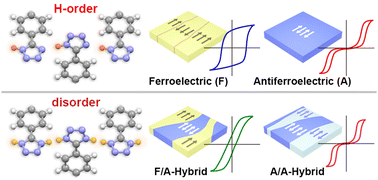Competition of polar and antipolar states hidden behind a variety of polarization switching modes in hydrogen-bonded molecular chains†
Abstract
Switchable π-electron systems are very powerful fragments to emphasize ferroelectric or antiferroelectric polarizations up to record-high levels among organic molecular crystals. According to the Cambridge Structural Database, many azole crystals such as imidazoles and tetrazoles contain polar and bistable hydrogen-bonded molecular sequences suitable for ferroelectricity or antiferroelectricity. Indeed, polarization hysteresis experiments on the 5-phenyl-1H-tetrazole (PHTZ) family combined with single crystal structural analysis have revealed one ferroelectric, two antiferroelectrics, and two hybrid-like dielectrics. Here, the rich variations for the interrelation between the hydrogen-bonding states and the polarization switching modes are interpreted by density functional theory (DFT) calculations with an excellent consistency. Large switchable polarizations are theoretically confirmed, and, as expected, the largest contribution is the switchable π-electron systems. By mapping the energy levels of polar/antipolar states, the disordered hydrogen bonds always appear when the ground state is accompanied by a nearly degenerate state. The straightforward case is the hybrid-like dielectric caused by the competition between the polar and antipolar states. However, contrastive behaviors are observed when the switchable dipoles are involved in competition between the different antipolar arrangement. For example, the PHTZ crystal exhibits typical antiferroelectric switching regardless of the hydrogen disorder, whereas polarization switching is silent in the imidazole derivatives. The latter is explained by the switching field increase with depth of the ground state relative to the energy level of the polar state.



 Please wait while we load your content...
Please wait while we load your content...